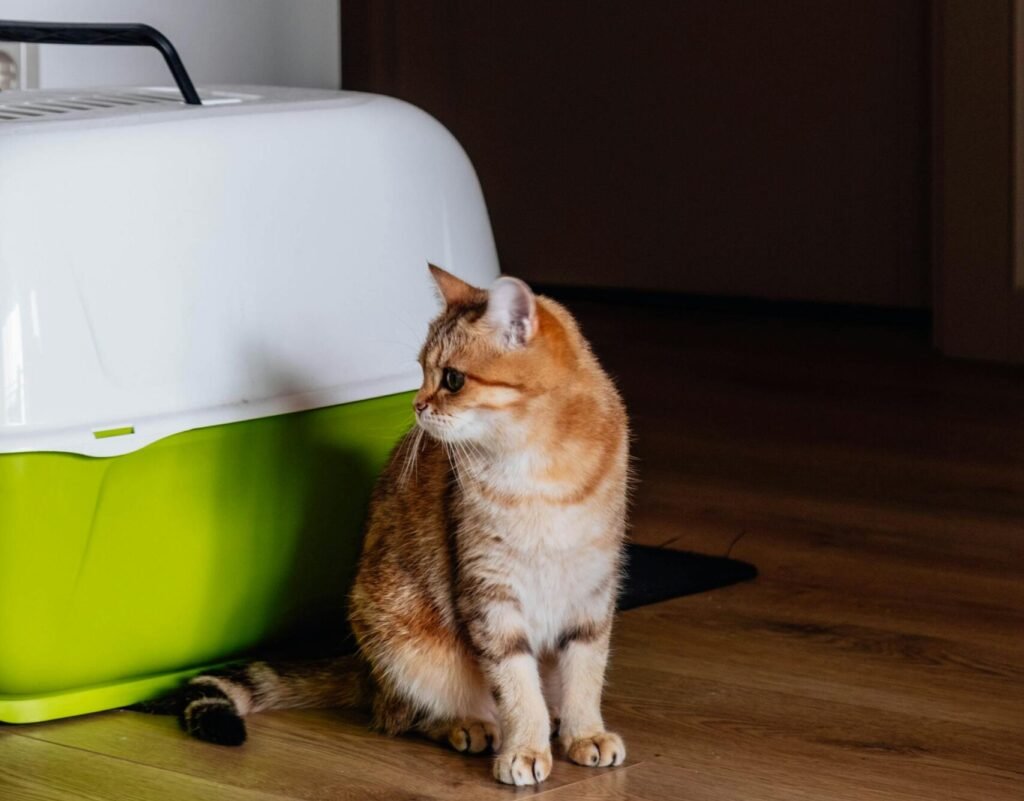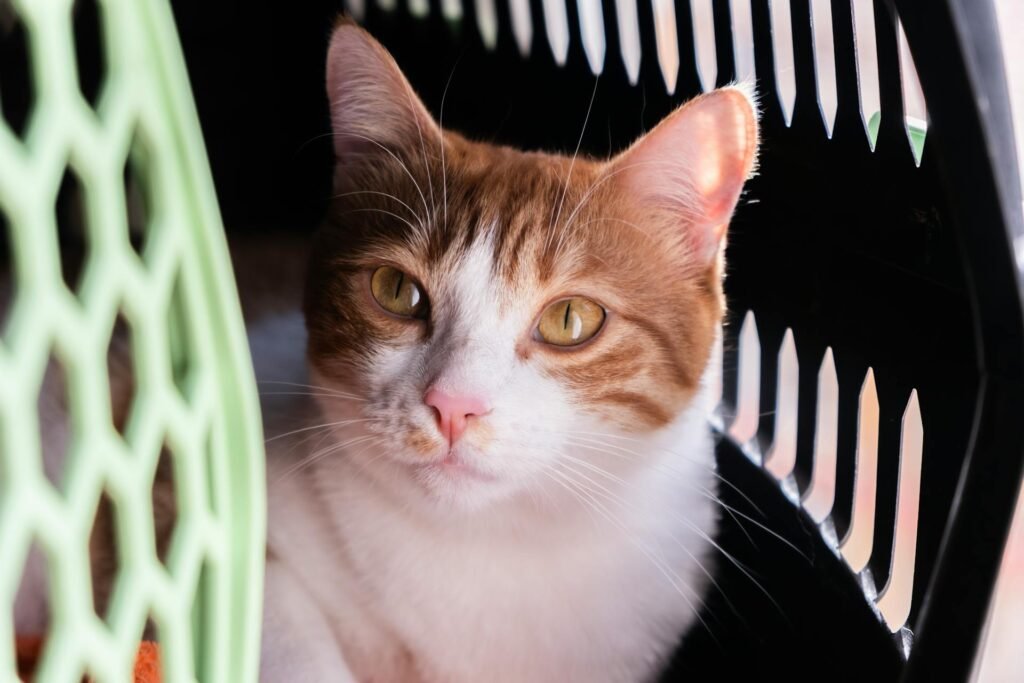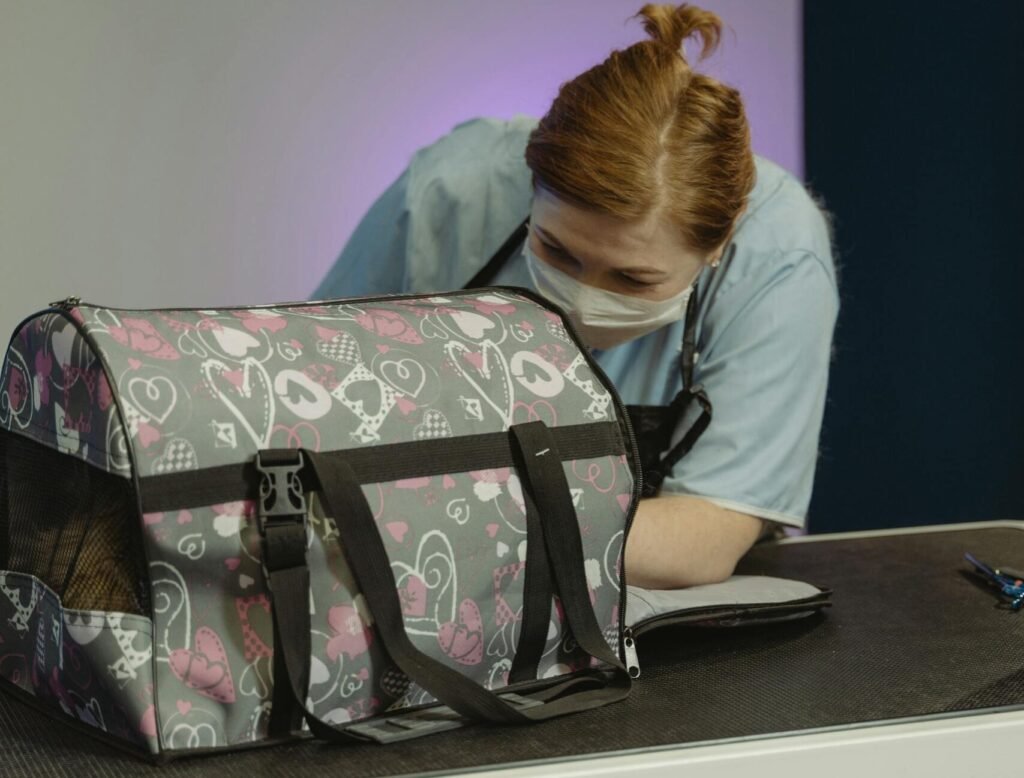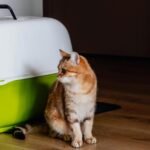Your cat gives you that look, the one that says they know exactly what’s about to happen. The carrier comes out, and suddenly your confident feline friend transforms into a escape artist. Sound familiar? The truth is, many cats dread their carrier because we haven’t found the right one for their personality and needs. Whether you’re planning a vet visit, moving across the country, or taking your first airplane journey with your furry companion, choosing the right cat carrier makes all the difference between a stressful ordeal and a manageable experience.
Let’s walk through everything you need to know about the different types of cat carriers and how to choose one that works for both you and your whiskered travel buddy.

Why the Right Carrier Matters More Than You Think
Before we jump into the types of cat carriers available, it’s worth understanding why this purchase deserves more thought than grabbing whatever’s on sale. A quality carrier isn’t just about transportation, it’s about your cat’s sense of security during moments when their world feels unpredictable.
Cats are creatures of comfort and routine. When something disrupts that routine, they need a space that feels safe. The right carrier becomes a temporary den, a familiar spot that smells like home even when everything else feels strange. Beyond comfort, there’s the practical side: a poorly chosen carrier can turn a simple vet visit into an exhausting wrestling match, or worse, create safety hazards during travel.
We’ve all heard stories of carriers falling apart mid-trip or cats managing impossible escapes through weak zippers. These aren’t just inconveniences, they’re genuinely dangerous situations. Even if you’re only using a carrier once or twice a year, investing in something reliable protects your cat when they’re most vulnerable. Plus, critical traveling mistakes with cats often involve inadequate or inappropriate carriers that create stress for everyone involved.
The Main Types of Cat Carriers: Finding Your Match
Soft-Sided Carriers: Lightweight Versatility
Soft-sided carriers have become incredibly popular, and for good reason. Made from durable fabrics with mesh panels for ventilation, these carriers balance portability with comfort. They typically weigh much less than hard-sided alternatives, making them easier to carry when you’re juggling other items or navigating crowded spaces.
The mesh windows on most soft-sided carriers provide excellent airflow while letting your cat see out, or letting you peek in to check on them. Many designs include multiple entry points, usually one on top and one on the side, giving you options for coaxing reluctant cats inside. The top entry particularly shines when you need to lower your cat in gently rather than pushing them through a front door.
These carriers often come with adjustable shoulder straps and sturdy handles, giving you carrying flexibility. Some models like the Henkelion cat carrier even include loops that attach to luggage handles, which is brilliant for airport navigation. The collapsible feature means they fold relatively flat for storage, a huge plus for apartment dwellers or anyone short on closet space.
Soft-sided carriers work beautifully for cats who aren’t aggressive scratchers and who don’t panic to the point of trying to claw through fabric. They’re particularly well-suited for airline travel since most are designed with under-seat dimensions in mind. However, they’re not ideal if your cat tends to have accidents during travel, as fabric can be harder to clean thoroughly despite being washable.
Most soft-sided options accommodate cats up to 15-16 pounds comfortably, though larger versions exist for bigger felines or multiple cats. The included fleece pads in many models provide a cozy surface that can be removed and washed, which your cat will appreciate during longer trips.
Hard-Sided Carriers: Durability and Security
Hard-sided carriers represent the classic style many of us grew up with, and they’re still around because they genuinely work. Constructed from sturdy plastic with metal doors, these carriers offer unmatched durability and security. If your cat is an aggressive scratcher or tends to panic severely during transport, hard plastic won’t give way to frantic claws.
The two-door design has revolutionized hard-sided carriers. Traditional front-loading can be stressful for cats who don’t want to be pushed into a dark space. Carriers with top-loading doors solve this problem by letting you gently lower your cat in from above, which feels less threatening. Some nervous cats actually prefer the enclosed feeling of hard-sided carriers, they can’t see the scary stuff happening outside.

Cleaning is remarkably straightforward with hard plastic. After an accident or a drooling session, you can wipe everything down or even hose it out if needed. The carriers usually split into top and bottom sections, which makes thorough cleaning even easier. This feature also means you can use the bottom half as a familiar bed at home, helping your cat associate the carrier with positive experiences rather than just vet visits.
Ventilation comes from strategically placed holes or slots along the sides, top, and back. While not quite as airy as mesh panels, they provide plenty of airflow for most situations. The solid construction also makes these carriers excellent for car travel, they won’t collapse if something shifts in your trunk, and they provide good protection in the unlikely event of an accident.
The trade-off? Weight and storage. Hard-sided carriers are heavier and don’t compress for storage. They’re also bulkier for air travel, though many are still airline-approved if you check specific dimensions against your airline’s requirements.
Expandable Carriers: Extra Space for Longer Journeys
Expandable carriers are genius for situations where your cat needs a little extra room to stretch or access a small litter box. These innovative designs look like standard soft-sided carriers but feature zippered panels that extend outward, sometimes on multiple sides, creating significantly more interior space.
The expansion feature shines during extended travel. If you’re driving across several states or spending time in a hotel room, you can set up the carrier in its expanded form to give your cat a comfortable temporary living space. The extra room lets them stand fully, turn around easily, or even access small food and water bowls without everything getting knocked over.
When collapsed, these carriers maintain a compact profile suitable for airline cabins or tight car spaces. The frame systems typically use sturdy steel supports that lock into place, ensuring stability whether expanded or compressed. Quick-setup mechanisms mean you’re not fumbling with complicated assembly when your cat is already stressed.
Multiple Cat Carriers: When One Carrier Isn’t Enough
Sometimes you need to transport multiple cats simultaneously. While making separate trips works for routine vet appointments, moving or emergencies require everyone to travel together. Extra-large carriers designed for multiple cats provide the space and features to make this possible.
These spacious options often measure around 24 inches long, offering room for two average-sized cats to travel together comfortably. Some innovative designs even include removable dividers, letting you separate cats if they don’t get along or combine the space for bonded pairs who comfort each other.
The best multi-cat carriers include practical features like waterproof bottom liners (because accidents multiply with multiple cats) and reinforced frames that handle the extra weight without sagging. Multiple mesh windows ensure adequate ventilation when you’re transporting more than one furry passenger. Some models come with coordinated accessories like collapsible litter boxes and bowls, which are essential for longer trips with multiple cats.
Safety features become even more critical with multiple cats. Look for carriers with multiple safety belt loops that let you secure the carrier firmly in your vehicle. Reinforced zippers and safety clips prevent even the most determined escape artist from making a break for it.
These larger carriers also work beautifully as temporary safe spaces during home renovations or when introducing new pets to your household. The extra room means a single cat can have plenty of space to relax without feeling confined.
How to Choose the Right Size Cat Carrier
Here’s a mistake countless pet parents make: choosing a carrier based only on their cat’s weight. A 15-pound cat might be long and lean or compact and chunky. Those two cats need different carrier sizes despite weighing the same. Choosing the right size cat carrier involves actual measurements, not just the number on your veterinary records.

Measure your cat from nose to the base of their tail (not including the tail length). Then measure their height from paw to shoulder while they’re standing naturally. The carrier should allow your cat to stand up without their ears touching the top, turn around without contortion, and lie down comfortably on their side.
As a general guideline, add about 3-4 inches to your cat’s length and height measurements. This extra space prevents that cramped, uncomfortable feeling during travel. Remember that cats often feel more secure in snugger spaces than in carriers where they slide around, but there’s a difference between cozy and cramped.
For soft-sided carriers, pay attention to how the fabric behaves under weight. A carrier might have generous dimensions, but if the sides collapse inward when your cat moves, the actual usable space shrinks significantly. Sturdier frames with good support prevent this problem.
Weight limits matter too, but mostly for structural integrity rather than space. A carrier rated for 15 pounds might not physically accommodate a 15-pound Maine Coon with their long body, while it could be perfect for a compact British Shorthair of the same weight. Always prioritize measurements over weight recommendations.
Comparing Carrier Features: What Actually Matters
When shopping for carriers, you’ll encounter numerous features touted as essential. Some genuinely improve your experience; others are marketing fluff. Let’s break down what actually makes a difference:
| Feature | Why It Matters | What to Look For |
|---|---|---|
| Ventilation | Prevents overheating and helps anxious cats breathe easier | Mesh panels on at least three sides, ventilation holes positioned for cross-breeze |
| Entry Points | Multiple options reduce stress during loading | Top entry plus side entry; top entry particularly valuable for nervous cats |
| Structural Integrity | Prevents collapse and escape | Metal frame supports in soft-sided; thick plastic in hard-sided; reinforced corners |
| Cleaning | Makes maintenance realistic so you’ll actually do it | Removable, washable liners; smooth interior surfaces; separation capability for deep cleaning |
| Securing Options | Safety during transport | Seatbelt loops, luggage attachment points, non-slip bottom padding |
| Weight Distribution | Reduces strain during carrying | Padded shoulder straps, dual handles, balanced weight design |
| Visibility | Helps some cats stay calmer | Clear or mesh sides that you can optionally cover with a blanket if needed |
| Locking Mechanisms | Prevents mid-trip escapes | Metal zippers with locking sliders, secure latches that can’t be pawed open |
The most important features depend on your specific needs. Quick vet visits require less elaborate features than cross-country moves. Consider what you’ll actually use rather than accumulating features that sound nice but complicate the carrier unnecessarily.
Material Matters: Durability vs. Comfort
Cat carriers use several different materials, each with distinct advantages. Polyester and Oxford cloth dominate soft-sided carriers because they’re lightweight, fairly durable, and relatively easy to clean. Better-quality fabrics resist scratching and won’t tear easily when your cat kneads nervously.
Look for water-resistant or waterproof materials if possible. Even well-trained cats sometimes have accidents when stressed, and a waterproof layer prevents liquids from soaking into padding or leaking through to your car seat. Some carriers include removable waterproof bottom liners that add protection without affecting the overall design.
Mesh materials vary significantly in quality. Cheap mesh tears easily under determined claws, while better mesh uses reinforced threading that withstands scratching. The mesh should feel taut when installed, not saggy. Nylon mesh generally outperforms generic mesh in durability.
For hard-sided carriers, thick plastic provides the best longevity. Cheaper carriers use thin plastic that can crack, especially in temperature extremes. The plastic should feel solid without obvious flex when you squeeze the sides. Metal components like doors and hinges should be actual metal, not plastic painted to look like metal.
Padding and cushions inside carriers need to be removable for washing. Fleece is popular because cats generally like the texture, and it’s machine washable. Some carriers include multiple cushion options, letting you swap in a fresh one while washing the other.
Features That Reduce Stress for Both of You
Beyond basic structure and safety, certain features significantly reduce travel stress. Familiar scents calm cats dramatically, so carriers with removable cushions that you can leave in your cat’s favorite sleeping spots help tremendously. The cushion picks up their scent and home smells, making the carrier feel more welcoming.

Privacy options matter more than many people realize. While mesh panels provide great ventilation, some cats prefer darkness when scared. Carriers with cover flaps or the ability to drape a light blanket over them give your cat the option to hide while maintaining airflow. You can offer privacy without sacrificing safety.
Carriers with storage pockets might seem like a minor convenience until you’re carrying your cat, their paperwork, treats, and your keys while trying to open a door. Integrated pockets keep essentials accessible without requiring a separate bag. This matters especially during stressful situations where you need to access items quickly.
Some carriers include security straps that attach to your cat’s harness inside the carrier. These prevent escapes if zippers fail or doors accidentally open. While hopefully unnecessary, they provide peace of mind, especially during airline travel where escape could be disastrous.
Collapsible carriers solve the storage problem that stops many people from keeping carriers accessible. If your carrier lives in a basement or attic because it’s too bulky for regular storage, it won’t be handy for emergencies. Collapsible options fold flat enough to slide behind furniture or under beds, making them available when needed.
Introducing Your Cat to Their New Carrier
Even the best cat carrier in the world won’t help if your cat views it as a torture device. The introduction process matters as much as the carrier selection. Start by leaving the carrier out in a common area with the door open. Let your cat investigate on their terms without forcing interaction.
Toss treats inside daily. Put catnip toys in there. Feed meals inside the carrier if your cat is willing. The goal is creating positive associations rather than the carrier only appearing before stressful events. Some cats need weeks of gentle exposure before they’ll voluntarily enter a carrier, and that’s completely normal.
Make the carrier comfortable with their favorite blanket or bed inside. If they love curling into tight balls, a plusher cushion works well. If they sprawl, a flatter surface might suit them better.
Practice closing the door for short periods while your cat is inside. Start with just seconds, then gradually increase duration. Reward calm behavior with treats and praise. This preparation prevents panic during actual travel when they suddenly find themselves confined.
Some cats respond well to synthetic calming pheromones sprayed inside the carrier. These products mimic natural cat facial pheromones and can reduce anxiety. However, introduce any new scent gradually to ensure your cat doesn’t find it off-putting.
Car Safety and Setup
Securing your carrier properly in the vehicle protects your cat during sudden stops or accidents. The carrier should never ride loose on a seat or in the cargo area. Use seatbelts threaded through carrier handles or specialized safety straps to anchor it firmly. Some carriers include dedicated loops designed specifically for seatbelt attachment.
The backseat floor is often the most stable location for carriers during driving. This position minimizes jostling from bumps and turns. However, if your carrier is large or your cat calms when they can see you, securing the carrier on the backseat with seatbelts works too.
Avoid placing carriers in direct sunlight during car trips. Cars heat up quickly, and your cat can’t move away from hot spots. Position the carrier where air conditioning reaches it, and check frequently that your cat isn’t overheating. Watch for excessive panting, drooling, or lethargy as signs of heat stress.
For longer trips, plan stops where you can check on your cat, offer water, and provide reassurance. However, don’t open the carrier in the car unless your cat is wearing a harness and leash. Even the most docile cat can panic in an unfamiliar setting and escape through an open car door.
Maintenance and Cleaning
Regular cleaning keeps your carrier sanitary and prevents it from smelling like a vet clinic, which cats definitely notice and dislike. After each use, remove and wash any bedding or cushions. Wipe down interior surfaces with pet-safe cleaners, paying attention to corners where fur and dander accumulate.
For soft-sided carriers, spot-clean immediately after accidents to prevent stains and odors from setting. Most can handle gentle machine washing if needed, though check manufacturer instructions first. Air-dry thoroughly before storage to prevent mildew, which not only smells terrible but can make your cat sick.

Hard-sided carriers benefit from occasional deep cleaning where you separate the top and bottom halves and scrub everything. A mixture of white vinegar and water works well for removing odors without harsh chemicals. Rinse thoroughly since cats are sensitive to residual cleaning product smells.
Inspect carriers regularly for damage. Check zippers on soft-sided carriers for smooth operation and intact teeth. Examine mesh for tears or weak spots. On hard-sided carriers, verify that latches and hinges function properly and that plastic shows no cracks. Small damage that’s repaired promptly prevents bigger problems later.
Storage location matters too. Damp basements or hot attics can damage carriers over time. Store in climate-controlled spaces when possible, and keep them accessible enough that you’ll actually use them. An inconveniently stored carrier won’t help during emergencies.
When to Replace Your Cat Carrier
Carriers don’t last forever, even with good maintenance. Obvious damage like broken zippers, torn mesh, or cracked plastic means replacement time. However, more subtle signs also indicate a carrier has reached the end of its useful life.
If the structure no longer holds its shape properly, the carrier isn’t providing adequate protection. Soft-sided carriers that sag excessively or hard-sided carriers with persistent wobbles need replacement. Your cat deserves stable, secure transport regardless of the carrier type.
Persistent odors that don’t respond to cleaning suggest materials have absorbed too much over time. Even if technically functional, a carrier that smells strongly of previous vet visits or accidents will stress your cat. Sometimes the mental health benefit of a fresh-smelling carrier justifies replacement even when the old one still works.
Your cat’s needs change over time too. Kittens grow into adult cats requiring larger carriers. Senior cats might benefit from carriers with easier entry points than what worked in their youth. If your cat has developed new anxiety triggers or physical limitations, a different carrier style might serve them better.
Changes in your life circumstances might necessitate different carriers as well. Moving from car-only transport to needing airline-approved carriers, or going from one cat to multiple cats, means your original carrier no longer meets your needs. Rather than forcing inadequate equipment to work, investing in appropriate gear makes everyone’s life easier.
FAQ
What type of cat carrier is best for vet visits?
Hard-sided carriers with top-loading doors work exceptionally well for vet visits. The top entry makes it easier to gently lower nervous cats inside, and veterinarians can examine cats while they remain in the bottom half of the carrier, reducing stress. Soft-sided carriers work fine too if your cat isn’t an aggressive scratcher and you find them easier to carry.
How do I measure my cat for the right carrier size?
Measure your cat’s length from nose to the base of their tail (not including the tail) and their height from paw to shoulder while standing. Add 3-4 inches to both measurements. Your cat should be able to stand without their head touching the top, turn around comfortably, and lie on their side fully stretched. Never choose based on weight alone since cats of the same weight can have very different body proportions.
Can I use a soft-sided carrier for airline travel?
Most airlines prefer or require soft-sided carriers for in-cabin pet travel because they can compress slightly to fit under seats. However, always verify your specific airline’s requirements before booking, as rules vary. The carrier must still maintain enough structure to protect your cat even while being slightly flexible.
How often should I replace a cat carrier?
Replace carriers when they show structural damage, have broken zippers or latches, contain tears in mesh or fabric, or no longer hold their shape properly. Even without visible damage, replace carriers if they retain persistent odors after cleaning or if your cat’s size or needs have changed. With proper care, quality carriers typically last 5-10 years.
What’s the difference between airline-approved and regular carriers?
Airline-approved carriers meet specific size requirements to fit under airplane seats, which vary by airline. They typically must be soft-sided and have adequate ventilation. Regular carriers might be larger, hard-sided, or lack the specific dimensions needed for air travel. Always check with your airline about specific requirements regardless of “airline approved” labels.
Should I get a carrier with top or side entry?
Top entry works best for lowering reluctant cats in from above and is less threatening for many cats. Side entry is easier for cats who prefer walking in themselves. Many modern carriers offer both options, giving you flexibility. If choosing only one, top entry generally reduces stress for the majority of cats.
How can I help my cat not be afraid of their carrier?
Leave the carrier out in common areas with the door open so it becomes familiar furniture rather than something that only appears before stressful events. Feed treats and meals inside, place favorite toys in it, and never use the carrier only for vet visits. Practice short sessions with your cat inside before actual travel is needed. Some cats take weeks to become comfortable, so start early with patience.
Do cats prefer to see out of carriers or be covered?
This varies by individual cat. Some feel calmer when they can observe their surroundings, while others prefer the security of darkness. Look for carriers with coverage options, mesh sides you can optionally cover with a light blanket. This lets you adjust based on your cat’s reactions during travel.
What size carrier do I need for two cats?
For two average-sized cats (under 12 pounds each), look for carriers measuring at least 24 inches in length. Both cats need space to stand, turn, and lie down without being cramped together. Consider whether your cats actually get along, bonded pairs might comfort each other during travel, but cats who merely tolerate each other will stress both out in confined spaces.
Wrapping Up Your Carrier Quest
At its heart, this decision comes down to balancing your cat’s personality with your practical needs. Maybe you’ll end up with a sturdy hard-sided carrier that doubles as a safe space in your home, or perhaps a lightweight soft-sided one that barely takes up closet space becomes your travel companion. There’s no single perfect answer that works for every cat and every situation.
What matters most is that you’re thinking about your cat’s comfort and safety instead of just grabbing the first carrier you see. That thoughtfulness makes all the difference between a carrier that sits unused in storage and one that actually gets your cat where they need to go with minimal drama. Your future self (and definitely your cat) will thank you for choosing carefully now rather than learning through trial and error when you’re already running late for a vet appointment.
Remember, even the most expensive, feature-packed carrier won’t magically transform a cat who associates carriers with bad experiences. The introduction process and creating positive associations matter just as much as the carrier itself. But starting with the right type of carrier for your specific cat certainly doesn’t hurt. Here’s to stress-free travels and cats who don’t immediately transform into boneless escape artists at the sight of their carrier!
Looking for more? Explore our Cat Accessories section for more posts like this, visit the Blog for fun and insightful reads, or browse our full Cat Category for everything feline-related, from care to comfort.
Disclaimer: This article is for informational purposes only and does not substitute for professional veterinary advice. Always consult your veterinarian for diagnosis and treatment tailored to your cat’s individual needs. Please verify current product information directly on the retailer’s site before purchasing.
Check out our most recent articles!
- Different Types of Cat Carriers Explained: How to Choose the Right OneFrom nervous rescues to confident adventurers, every cat needs a carrier that fits their personality. Discover which type works best for your situation and how to help your cat actually accept their carrier without the usual drama.
- Funny Names for White Cats: Hilarious & Creative IdeasWhite cats deserve names as entertaining as their personalities. From sophisticated wordplay to hilariously ironic choices, discover how the right funny name transforms daily interactions with your snowy feline into endless moments of joy.
- Why Are Dogs Afraid of Thunder But Cats Aren’t (Usually)?Not all pets react the same way to thunderstorms, and there are solid biological reasons why. Understanding what makes dogs more storm-sensitive than cats helps you provide better support when severe weather strikes your area.
- DIY Halloween Costumes for Cats That Actually WorkNot all cats approach Halloween costumes the same way, which is why DIY designs win every time. From five-minute bandanas to elaborate bat wings, discover costume ideas that match your cat’s tolerance level while creating memorable moments you’ll treasure for years.
- The Best Spooky Cat Toys for This Halloween SeasonYour cat deserves to celebrate Halloween too, and the right toys make it happen. Discover why seasonal toys create more engagement than year-round options and how to choose the perfect spooky playthings for your feline’s unique personality.
- Safe Halloween Treats for Cats: Halloween Recipes and Portion GuidelinesForget the complicated recipes and store-bought novelty items. The simplest, safest, and most meaningful Halloween treats for your cat are probably already in your kitchen right now.
- Are Cats Scared of the Dark? Feline Nighttime Behavior ExplainedYour cat’s relationship with darkness is more complicated than simply “scared” or “fearless.” While cats boast impressive night vision, they can’t see in complete blackness, and what really unsettles them at night might surprise you.
- Funny Cat Halloween Costumes: From Pumpkins to VampiresHalloween costumes for cats have evolved from basic accessories to elaborate character transformations. Whether your feline embraces the vampire aesthetic or grudgingly tolerates a pumpkin hat, this guide helps you find comfortable, photo-worthy costumes that respect your cat’s boundaries while maximizing the adorable factor.
- Can You Give Cats Canned Pumpkin? Everything You Need to KnowCanned pumpkin has earned its reputation as a go-to remedy for cat digestive issues, but knowing when and how much to use makes all the difference. From understanding the fiber benefits to avoiding dangerous pumpkin pie filling, smart cat owners need the full picture before reaching for that orange can.
- Do Cats Sleep More in Fall? Seasonal Snooze Patterns ExplainedAutumn transforms even the most playful cats into professional nappers. But is your feline’s increased sleepiness just seasonal adjustment or something more? Here’s what’s really happening when the leaves start falling.










